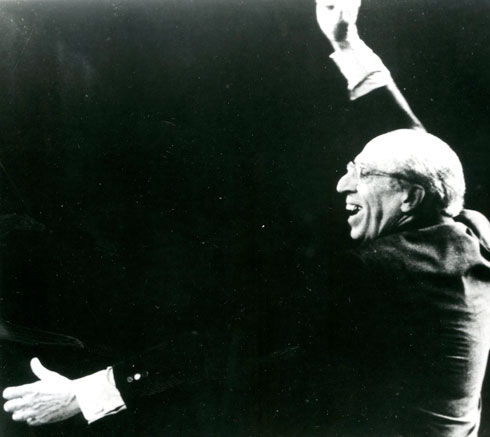There are many books and videos that teach the unschooled how to play an instrument in ten days, ten easy lessons, or even ten minutes. However, I have yet to see this type of super-instruction for band directing, and I think it’s about time we added something similar to the accelerated-training canon. You may be asking yourself if this accelerated training has any practical value. Unfortunately, yes. With rampant school budget cuts, almost anyone might be asked to direct a band. Administrators can hand this to their novice charges and expect a great band concert if they master these ten easy lessons.
Lesson 1: Purchase a baton. This is your only expense, but it’s worth it. The baton is your instrument and adds an air of mystery and authority to your persona; no one else in the group would dare have a baton. If you are receiving a typical teacher’s salary, you might not be able to afford a baton. In that case, use a pen, pencil, rolled up piece of paper, or maybe a carrot or stick of celery if you are a vegetarian. A crowbar obtained from shop class might work even better if the band is unruly and a more authoritative look is desired.
Grip the baton with the right hand somewhat like you would hold a toothpick when picking your teeth, except with the palm of the hand facing downward. If you’re a lefty, that’s too bad. Use the right hand. We just don’t do it that way, even though actor Richard Dreyfuss conducted left-handed in Mr. Holland’s Opus and ruined the whole movie for me.

Lesson 2: There are actually conducting patterns for your arm to make while holding the baton, but don’t worry about them. Many of the world’s greatest directors have an indecipherable pattern, although it is debatable whether they are aware of this. As long as you wave your arms expressively, you should be fine. No one but the audience is watching anyway, and what do they know? For developing your expressive conducting, I recommend watching The Karate Kid (wax on wax off, etc.).
Lesson 3: The left hand is used to turn the pages of the music. It also can indicate dynamics, unless you are conducting a pop or rock arrangement, where it will not be needed for dynamics at all. To indicate dynamics, raise the left arm up and down, palm up while raising the arm to increase volume, and palm down while lowering the arm to decrease sound.
Lesson 4: While conducting, you should hold the shoulders back, looking proud and in command. Such a regal pose is preferred, but there is some merit in gyrating your body around like you’ve been hit with a taser. If you prefer this more spastic style or just can’t help it, tell anyone who will listen that you are a conducting disciple of Leonard Bernstein. He composed Overture to Candide and the score to West Side Story and was the music director of the New York Philharmonic from 1958-69. That’s about all you need to know. (It’s all I know, and I have gotten along just fine.) I would also suggest growing your hair out so as your head swivels it will sling majestic arcs of sweat onto the ensemble.
As for starting your band, “One, two, ready play” should get about any piece you play off to a good start.
Lesson 5: Facial expressions are an important conducting tool. Lift your eyebrows. Furrow your eyebrows. Purse your lips. Smile. Scowl. A more recent trend is the stank face. Ironically, though similar to a look of scorn, when performed correctly it actually shows approval of what you just heard. Younger band students will play better than ever if they see this from the podium. However, careful practice is required. There is a fine line between a look of approval and that of acid reflux.
Lesson 6: Verbal communication should brief, to the point, and authoritative; this is desired because you probably don’t have much good to say anyway. Here are some words and phrases that are helpful:
“One more time.” Do it three more times.
“Watch your dynamics, __________.” You will most likely say this to the trumpet section, so call on them if in doubt.
“Play in tune, __________.” If you are unsure what the problem is, your best bet would be to call out the trombones. Another option is the flutes if they are playing in their upper range and sound similar to screeching tires.
“Subito.” Use this word anytime you want them to do something suddenly; even when they’re loading equipment.
‘You’re rushing the semiquavers.” This will send them to their music dictionary apps.
“Move like Jagger.” I’m not sure what this means, but it sounds cool.
If anyone gripes about your fluctuations in tempo, tell them that you “prefer a rubato interpretation of that passage.”
“Dolce. Dolce. Dolce.” Hold up a shaking left hand like an Italian chef and say with as much lilt as possible when you want something performed very sweetly.
Say “molto” before anything you want more of, such as, “molto ritardando” or “molto valve oil.”
Lesson 7: Choosing repertoire is important to your success. Your best chance of success is to program pieces that everyone will recognize; people love what they can relate to. The risk here is that if your band is playing poorly, the audience might not recognize what the band is playing, but that is a risk you will have to take. However, if anyone complains, you can always say it was a poor arrangement. Disney tunes, Elvis’s greatest hits, popular musicals, novelty songs, and patriotic medleys are safe bets to stir enough emotion to cover a multitude of musical sins.
Lesson 8: On the off-chance that you meet another (real) band director, you must know how to hold a proper conversation. Begin every conversation with “What are you playing at contest this year?” Other topics of interest: fundraisers (mattress sales are really big right now), administrator woes, battles with parents, school scheduling, and the high price of contrabass clarinet reeds. If you are feeling bold, do a little name-dropping as you discuss what you are playing: “We’re playing Goose Island Serenade, and my interpretation closely resembles that of Andy Clark’s on the 2003 Barnhouse demo.”
If you are really daring, carry around a score of Lincolnshire Posy and say you have been looking it over, but are not quite sure you have the horses to pull it off.
Lesson 9: Reading the musical score is important, but memorizing works from YouTube is even more so. You can find almost anything on YouTube, but if you cannot find it, don’t play it. If you’re asked why you never look at the score and are questioned about the accuracy of your teaching, say, “Music is more than what’s written on the page.”
Lesson 10: When the big day comes for your first concert, make sure you are dressed for musical success. A black tuxedo with tails would dazzle everyone in sight, but if you are on a budget, black slacks and a black turtleneck or blouse would work. If you already blew your budget on the baton, dark jeans and a black AC/DC or Metallica t-shirt can get you by in a pinch.
If followed faithfully, these ten lessons should help novice directors survive one school year before anyone figures out that they don’t know what they are doing. But who knows? They may even make a career of it.







